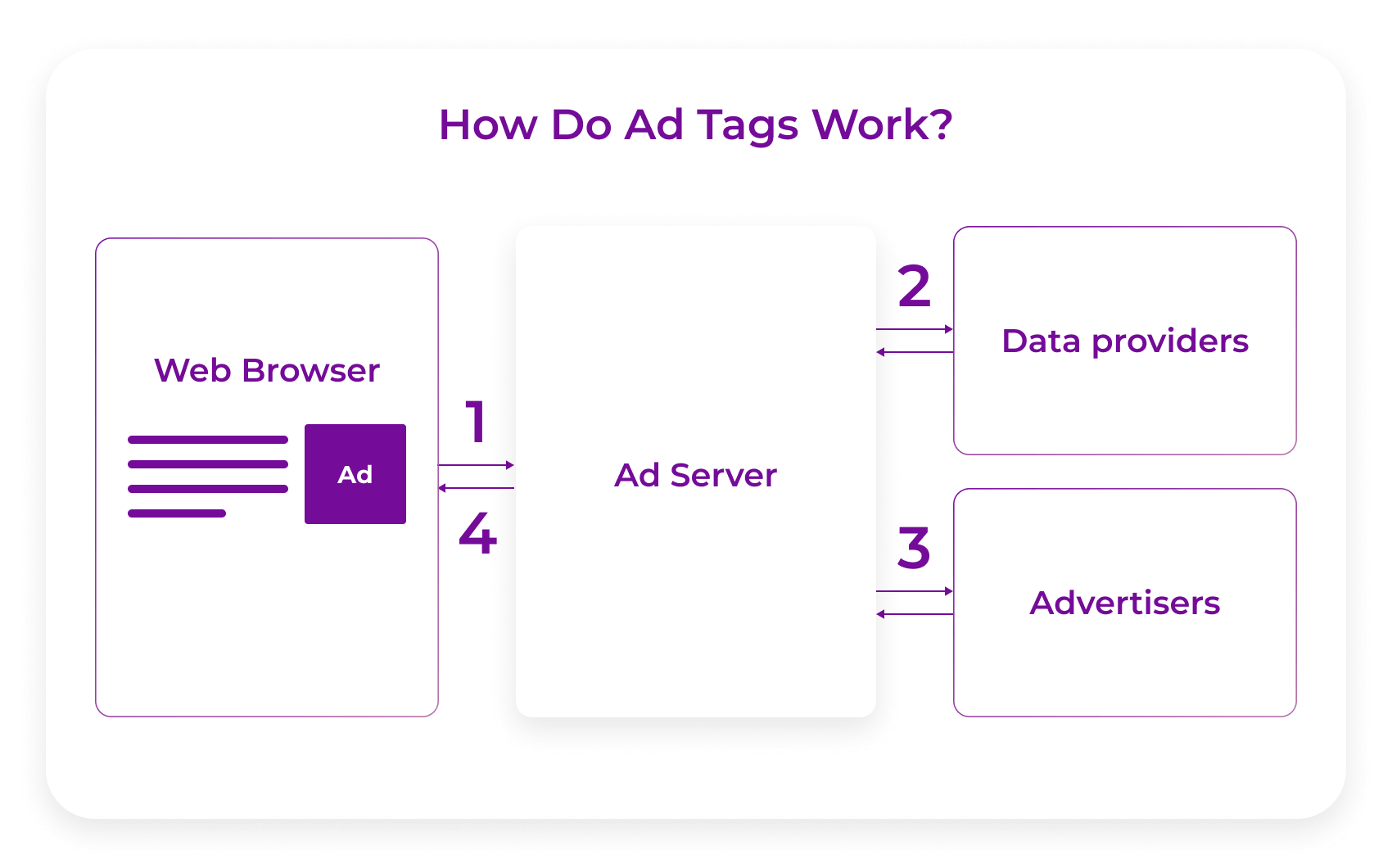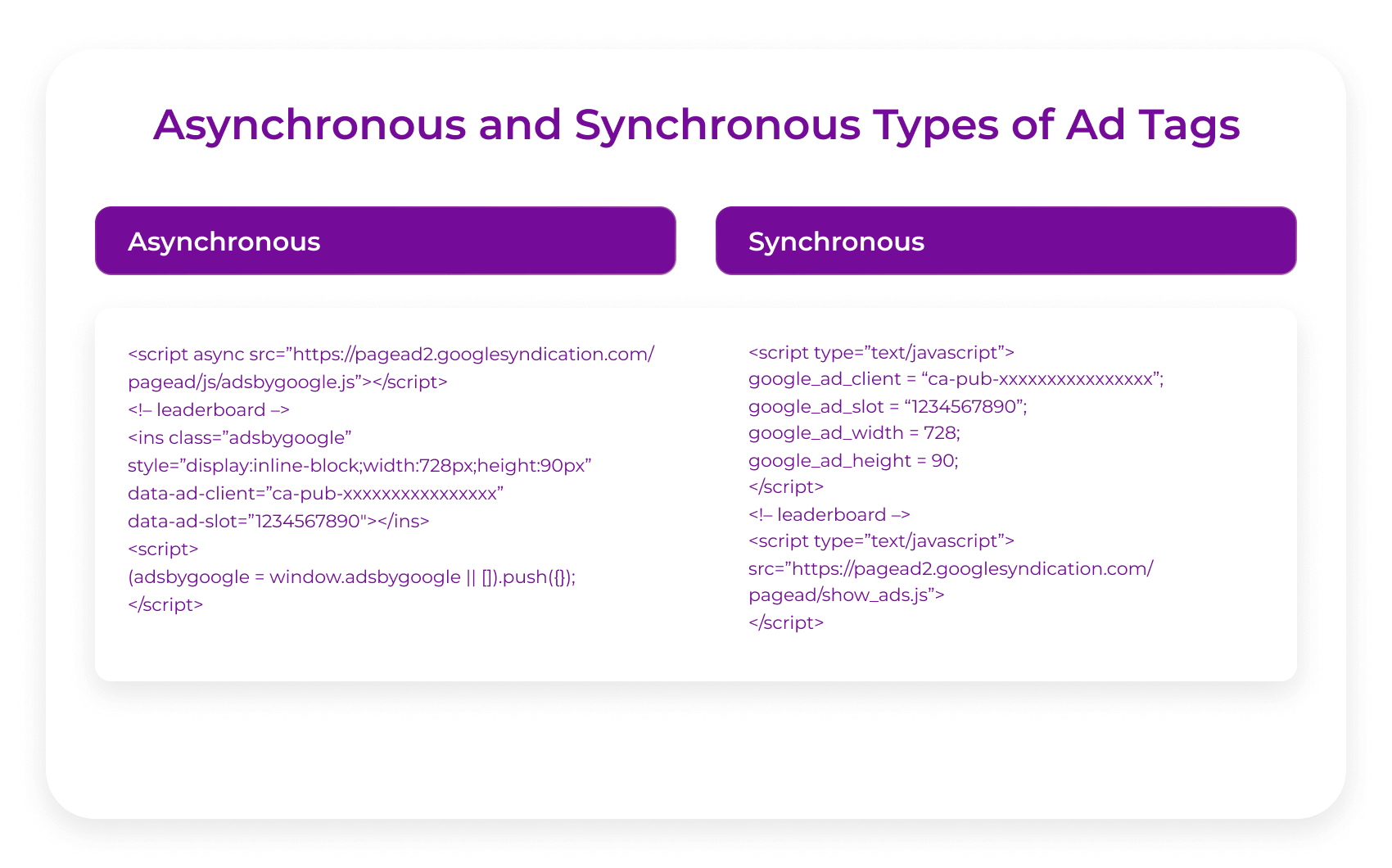Advertising tags are often mentioned in the context of the digital advertising industry as they are gluing elements that enable a smooth ad-serving process. These elements are useful for publishers, advertisers, and networks. But how exactly can a small piece of code play such an important role? Let’s find out!

Evolution of Ad Tags
Back in the dawn of the Internet, we actually didn’t have ad tags that served as organizers of the ad-serving process. That’s why user experience on the web page could turn into a horrible journey, and at times, it was almost impossible to browse through the content brimming with hordes of ads.
For instance, video commercial delivery was often a nightmare before the invention of VAST tags – advertisers faced challenges with inconsistent ad delivery, compatibility issues of different video players, and, thus, difficulties in tracking performance metrics accurately.
The introduction of VAST tags capabilities enabled advertisers to establish a single protocol that unifies ad serving across different players and inventory types, making the process universal. Plus, it made video ad serving possible even outside of players, which is very convenient.
As the internet grew, so did advertising demand, leading to the emergence of JavaScript tags. With these, dynamic content and advertising tracking capabilities flourished, ushering in an era of personalized marketing strategies.
Here are just a couple of things that were made possible during the last couple of years:
- Displaying of different ad sizes on the same inventory
- Serving of dynamic and expandable creatives
- Ad tags turning lightweight for servers and becoming universally supportable for almost all kinds of browsers.
What is ad tag
What are tags in advertising, and what role do they play in it?
An ad tag is an HTML or JavaScript code added to the website to enable loading, displaying, and tracking of creatives. Those are used for various purposes, such as to signify the space for ad placement, send ad calls to third-party ad servers, and enable tracking and reporting features.
The most important role that it carries – it basically indicates to the system how creative should be displayed, where, and at what circumstances.
They can include a wide range of details about creatives, such as their size, format, basic page info, information about users, and many more.
Why do we need creative tagging?
Properly implemented ad tags make the programmatic ecosystem simpler and more convenient. They perform a range of essential functions for every member of the media trading process.
Ad tagging for publishers:
The primary function of original tags is to generate bid requests that inform advertisers that inventory is available for sale. By creating such units and inserting them into the source code, publishers build a foundation for their website monetization.
If you're a digital advertiser, how do you define a tag?
Here, those tags are used to request and display advertisers' creatives within the inventory slot on the web page. They are also applied to report how the impression gets served on the website; this enables advertisers to build a better programmatic ads strategy.
For ad servers:
Ad servers use tags generated by the publishers to move ad calls and enable the trading process. Next, requests for bids are created so that the auction can start. Thanks to this, the inventory is then passed to the next steps of the exchange chain.
What about other services?
The usage of third-party ad tags makes it possible to perform some additional features. For example, data-management platforms use creative tagging to gather user data, which can then be utilized for analyzing the target audience persona.

5 Main principles of how ad tags work
We’ve just found out that ad tags meaning and role in advertising can be tremendous. Now that we have a definition of what is an ad tag and why we need it, it is time to take a more in-depth insight into the main principles of their work. We can examine the process by dividing it into these five simple steps:
Step 1. Publisher’s installation
First things first, the publisher has to insert a JavaScript or HTML code on the web page, which will specify what kind of placements are available for sale. It is also up to publishers to define how exactly they want their tags to work and what functions they should perform.
Step 2. Activation and call to server
When the visitor enters the website, an ad tag is activated, and a call is sent to the publisher’s ad server while the page is loading. It receives the data about available creatives and sends requests to the third-parties for additional information, if applicable.
Step 3. Fetching the data
A third-party data provider returns this request along with gathered information about the user to the server of the advertiser (or it can be a DSP). It can then be used to enable targeting and reporting.
Step 4. Playing a role in the auction
Next, advertisers receive requests that offer to participate in real-time bidding auction, where the highest-bidding advertiser wins (so their ad is getting served).
Step 5. Fetching the creative
Ad server of the advertiser (or it can be a DSP) attaches the URL to the tag, which provides the data about where the creative is located. The publisher’s server utilizes this URL to fetch the creative and serve the impression.

Types of ad tags
There two types of these advertising mechanisms one should take into consideration:
Synchronous ad tags
Synchronous ad tags load with the content of the website. They are usually loaded sequentially, which is why page latency may occur in some cases.
Asynchronous ad tags
load independently on the browser so that the ad serving doesn’t affect page load time. Because of this, most publishers prefer an asynchronous type. Plus, they are often available on the platforms by default.
Now, let’s proceed to review ad tags example.

A reading of an ad tag example:
Here is a simple ad tag example from DoubleClick - let’s take a look at its elements and explore their meaning:
http://ad.doubleclick.net/ADJ/publisher/zone;topic=abc;sbtpc=def;kw=xyz;tile=1;slot=728x90.1;sz=728x90;ord=7268140825331981?
http://ad.doubleclick.net/ - this first element specifies the ad server and its host address. In this example its DoubleClick which has by now merged into Google Ad Manager;
/ADJ - this part defines what kind of response is expected - images served via JavaScript for this case;
/publisher - this code distinguishes publisher properties in publisher networks;
/zone;topic=abc; sbtpc=def;- this part specifies zone, a topic and subtopic within the website; for example - News, Hobbies, or Sports. Including this information makes targeting more precise and relevant;
kw=xyz - this part includes keywords for the creatives - there can be one or multiple; tile=1 - a unique value is given to each ad call that prevents the same ad from appearing at multiple placements at the same time;
slot=728x90.1;sz=728x90; - a couple of specifications for the ad slot - its size and ordinal number;
ord=7268140825331981? - this part prevents the browser from loading the same ad from the cache when the user returns to the same page;
Regulatory compliance: What’s coming next in evolution?
The rise of mobile devices brought new challenges, met by responsive ad tags capable of adapting to diverse screens and platforms. Programmatic advertising then revolutionized the game, introducing real-time bidding and automated optimization. Yet, amid this progress, concerns over privacy and data security arose, prompting the need for GDPR and CCPA compliance.
So, advertisement tag, how will it change in the future to address these challenges? Their mechanism will definitely be:
- Integrated with Consent Management Platforms (CMPs) to ensure compliance with regulations;
- They will focus more on analyzing the context of the content as the world is moving toward a cookieless future and embraces contextual targeting;
- They will employ techniques like anonymization and pseudonymization of data;
- Their mechanism will incorporate mechanisms for providing users with transparent information about how their data;
- Adtech companies will implement rigorous auditing and compliance checks to ensure that those tags adhere to privacy regulations.
Overall, the future evolution of ad tags will be shaped by a combination of technological advancements, regulatory requirements, and industry standards aimed at balancing the need for targeted advertising with user privacy protection.
Conclusions
Advertising tags play an important role in the digital advertising industry, as they are essential for almost every step of the media trading process. The usage of creative tagging helps publishers start effective website monetization that exponentially increases their revenues. At the same time, for advertisers, creative tags provide a perfect opportunity to launch precisely targeted display advertising campaigns.
Power up tag-driven ad campaigns as an advertiser on SmartyAds DSP!





